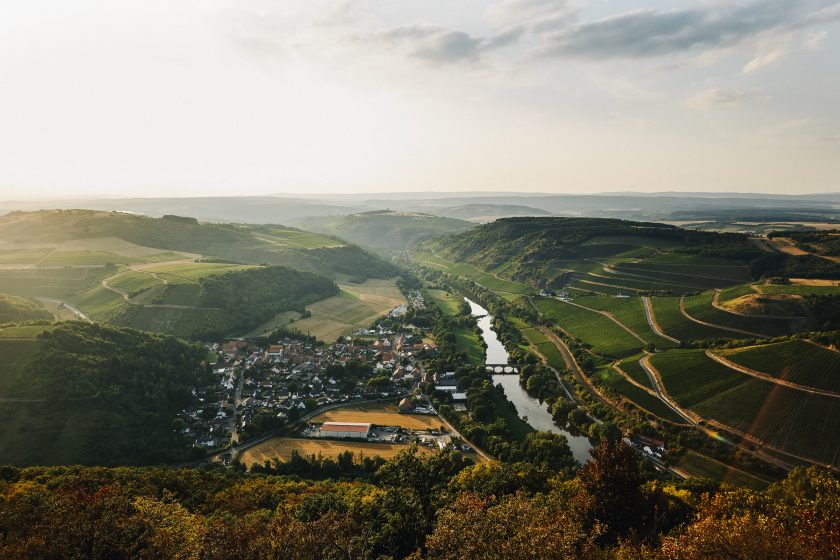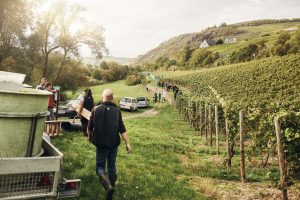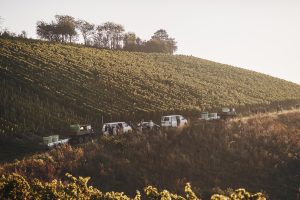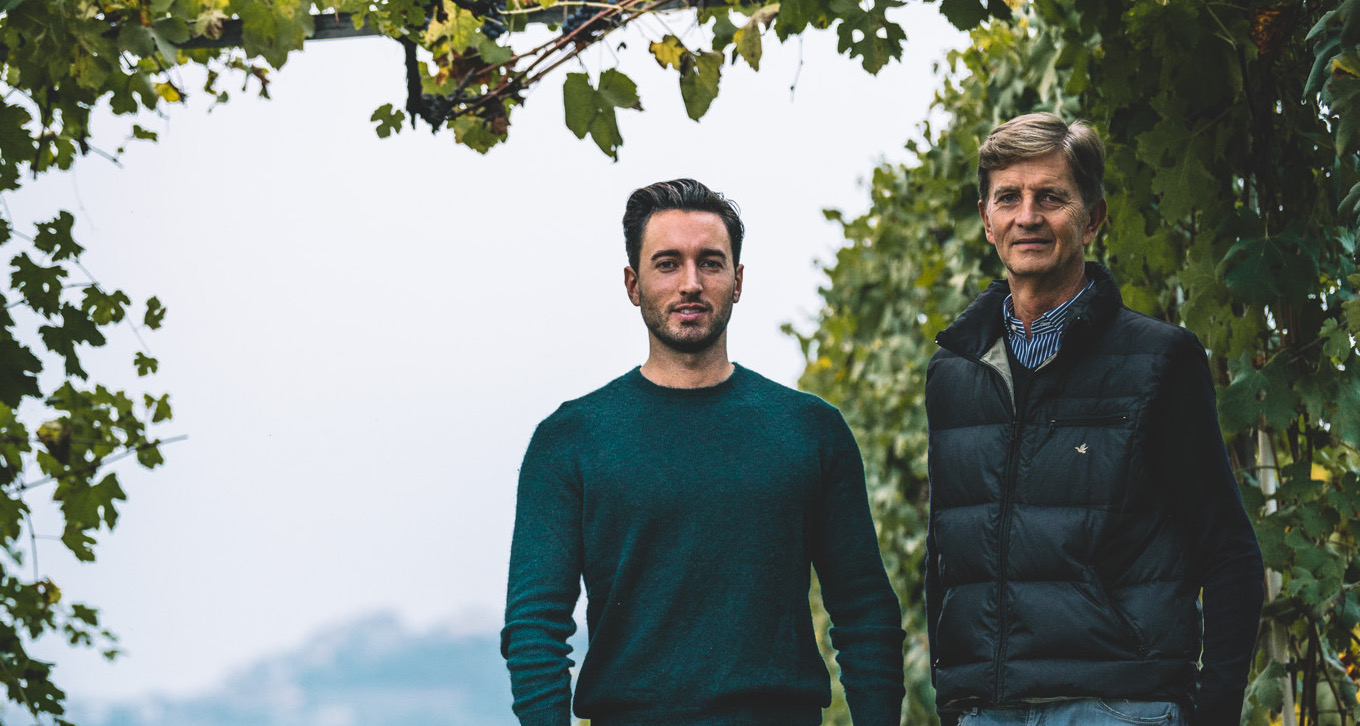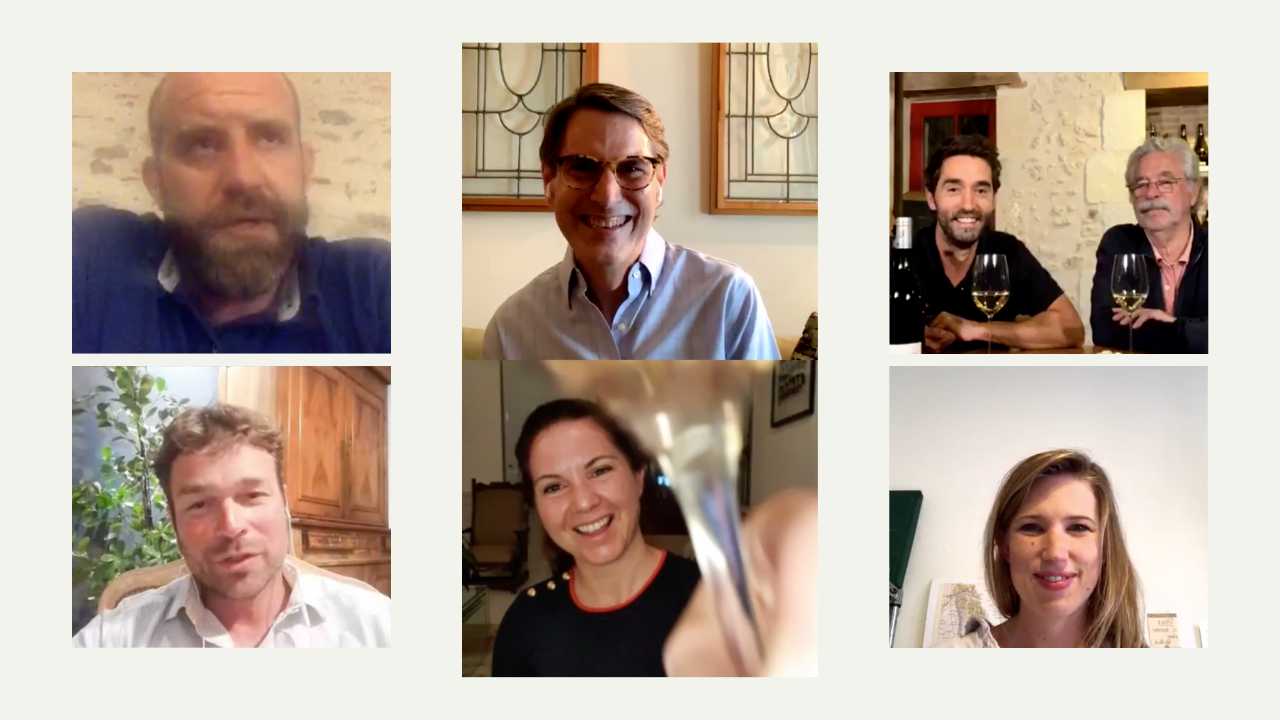Tasting at Dönnhoff in Oberhäusen is always a high-water mark for the vintage. We were able to taste with Cornelius Dönnhoff earlier this year and while 2019 was not an easy harvest to bring in, the hard work in the vineyards produced an outstanding collection.
We had 50 people at harvest for this vintage, the same number as in 2014. This is the largest team that we have used, and the work was very difficult. It is because of their hard work that the wines are at this quality level. From sunup to sunset we sorted and pressed fruit.Cornelius Dönnhoff
The sorting during this vintage was paramount and the work that it entailed was demanding. “You woke up early each day, exhausted from the long day before and you had to do it over again,” said Cornelius.
All this effort paid huge dividends with a collection that shows a great balance of flavors. 2019 is elegant, with great structure and complexity. This vintage offers a different set of flavors after the sunny warmth and broad texture of 2018. It’s a calm and collected vintage that shows a spectrum of non-fruit flavors without the overt juiciness of the previous year. The wines have superb structure while maintaining the crystal-clear delineation at the single-site level that we always find here in Oberhäusen.
The GGs are incredible this year, but they have been excellent each year. “The selection and total production of the GGs this year is much smaller, but in the end, the only thing that matters is the overall quality of the wines,” remarked Cornelius. 2019 seems to be a vintage that plays equally well to prädikatswein as well as the dry end of the spectrum. The trio of 2019 Kabinetts is outstanding while the structure and balance of the Spätlesen and Auslesen will age for decades.
The Sites:
The two basic Rieslings in both the dry and what the Germans refer to as “fruchtig” or “fruity” style are benchmark wines in both idioms.
The basis for these wines are two vineyards in the hills behind the village of Oberhäusen: Oberhäuser Kieselberg (slate) and Oberhäuser Felsenberg (volcanic).
“The basic wines are the wines that most people will taste first, so we have to make them as good as they can possibly be,” says Cornelius who has been in charge of the Domaine since 2007. Helmut Dönnhoff, Cornelius’ father and the winemaker who almost single-handedly put the Nahe on the map said “The level of quality that Cornelius is producing the basic wines was simply not possible in my era. His efforts and adjustments in the vineyard can be tasted in the finished wines”.
The 2019 Riesling Trocken is snappy, classic and shows a pleasing herbal character while the off-dry version feels perfectly balanced between ripe fruit and crisp structure.
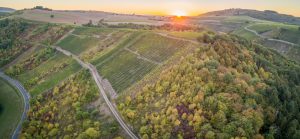 Oberhäuser Leistenberg
Oberhäuser Leistenberg
Oberhaüser Leistenberg (weathered and decomposed grey slate) is a steep, southeast facing Grand Cru vineyard in a side valley of the Nahe. The direction of exposure allows the morning sun to dry out moisture in the vineyard while the afternoon sun is less intense than the full south exposed vineyards. This provides a long ripening period and slows the development of botrytis. The vineyard name has two meanings: “Leisten” means “achieve” in German while “Lei or Lay” is an old German word for slate, the dominating soil type.
Leistenberg is the basis for two excellent wines each year: Tonschiefer Trocken, a dry Kabinett quality wine, and Leistenberg Kabinett, the off-dry single site wine.
In addition to the main component of Leistenberg, Tonschiefer is partially made from declassified GG fruit. It’s more complex than the Estate Riesling Trocken though it’s not more textured or richer. It has a very pretty, floral quality which adds another layer of complexity. Leistenberg Kabinett has a salty, ripe citrus flavor which makes it a pleasure in its youth, but also benefits from long aging.
Kreuznacher Kahlenberg
Kreuznacher Kahlenberg (gravelly loam) in Bad Kreuznach, is a top site, but Cornelius bottles it as an Erste Lage (1er Cru) – Kahlenberg Trocken. “You can’t drink a GG every night. Sometimes you need a wine that is not quite as complex, one that delivers site, but also drinkability. That should be the marker of a good Erste Lage in my opinion,” says Cornelius.
Soils are richer in the vineyards in Bad Kreuznach, where the valley opens. The area is quite a bit warmer than Niederhäusen and Oberhäusen. Kahlenberg is a vineyard that was purchased by Helmut, Cornelius’s father, and has a very special connection to him; “My father actually planted this vineyard while he was at the viticultural school in Bad Kreuznach, in 1966. He purchased it in 2002 and really loves this place”.
In comparison to Tonschiefer, Kahlenberg Trocken has more texture and body with a solid character that will please a wide array of drinkers.
Kreuznacher Krötenpful
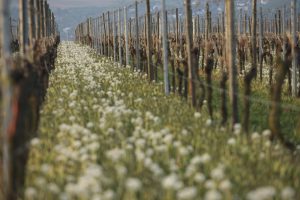 Kreuznacher Krötenpful (loess, loam, and quartzite) is a site that Dönnhoff produced just a single wine from for many years. “It’s a really nice site for Kabinett, making a riper wine than Leistenberg, but with great acidity still”.
Kreuznacher Krötenpful (loess, loam, and quartzite) is a site that Dönnhoff produced just a single wine from for many years. “It’s a really nice site for Kabinett, making a riper wine than Leistenberg, but with great acidity still”.
The vineyard sits just behind the town of Bad Kreuznach, a quartz-rich hilltop plateau with a steep, south-facing section, angled towards the village. In 2017 Cornelius produced Krötenpfuhl Grosses Gewächs for the first time when frost reduced the crop and concentrated the always small berries here even further.
The GG is made from the steepest section of the vineyard and feels open and charming. It is the most approachable of the GGs in its youth. The spicy and bright Krötenpfuhl Kabinett comes from the quartz-rich plateau and while it’s not quite as saline as the Leistenberg, it’s extraordinarily drinkable.
Roxheimer Höllenpfad
Roxheimer Höllenpfad (red sandstone) was acquired in 2010, a vineyard with a strong connection to the family; Helmut’s brother-in-law farmed this vineyard, making wine under the Gutleuthof label. Höllenpfad, which means literally “path to hell” is a steep, south-facing side valley of the Nahe.
The soils here are Rotliegend (middle Permian sandstone) and decompose to produce sandy topsoil. This is a very rare soil type in the Nahe, similar soil to Kastanienbusch in the Süd-Pfalz and the Roter Hang of Nierstein in Rheinhessen. The name may originate from the red soil or the steep, south-facing aspect.
Dönnhoff produces two wines from this site, the 1er Cru or Erste Lage called Höllenpfad Trocken is the dry wine not from the center Grosse Lage (Grand Cru) section of this beautiful vineyard in Roxheim. While the vineyard is south facing, the Höllenpfad trocken is cool in tone, showing a green herbal character that might remind you of fresh, sweet kitchen herbs.
Höllenpfad Im Mühlenberg is a special site within the larger Höllenpfad vineyard. This is the center and steepest section of the vineyard and classified as Grosse Lage or Grand Cru. From this vineyard, Dönnhoff produces the Im Müllenberg GG, first bottled in 2017. The GG wine has more of everything that the “normal” Höllenpfad possesses while maintaining the particular texture of the site. It is at finely knit and detailed but with a depth and length that is unmistakable. It is not a charmer, like the wines from Bad Kreuznach, showing a stiffer, firmer structure.
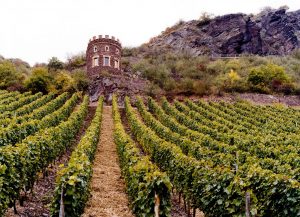 Schlossböckelheimer Felsenberg
Schlossböckelheimer Felsenberg
Schlossböckelheimer Felsenberg (volcanic porphyry and decomposed melphyr) is a very old and very famous site, directly on the Nahe river. It’s extraordinarily steep and the soil here is pure volcanic: “you can see that there is almost no topsoil here; we have to promote humus with hay and other organic material” says Cornelius, walking along the bottom of the vineyard. Looking up, the vineyard, cliffs, and forest above show the gradient. “This is one of the very difficult vineyards to work, it’s just so steep and nothing to hold you up. It’s just rocks,” says Cornelius.
In some vintages, two wines are produced: a Spätlese when conditions are right and almost every year the smokiest and most powerful Grosses Gewächs bottling of the collection.
The GG comes from a sub-parcel of the vineyard, around the Felsentürmchen, the small tower in the middle of the hill. Smoky and mineral, Felsenberg shows the volcanic cragginess that anyone who visits this vineyard in Schlossböckelheim will remember. “Felsenberg is the god of thunder,” said Cornelius, which is as accurate a personification of a wine as we’ve heard.
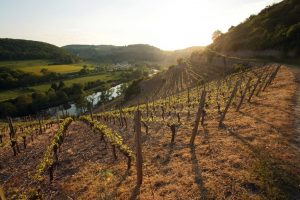 Norheimer Dellchen
Norheimer Dellchen
Norheimer Dellchen (grey slate over porphyry and melaphyr) is a very small, very steep amphitheater shaped vineyard just upriver from Oberhäusen and Niederhäusen. The name refers to “small hallow” where the vineyard is planted, between volcanic cliffs, facing south.
From this small site, a single Grosses Gewächs wine is produced. Dellchen GG is powerful but graceful, always showing the bright sunny quality of the vineyard. In 2019 Dellchen is a perfect complement to the mineral, rugged Felsenberg – it’s bright, beautifully delineated, and tastes of pure sunshine.
Norheimer Kirschheck
Norheimer Kirschheck (grey slate and sandstone) faces south and produces a delicious and luscious Spätlese each year. The name ‘Kirsche’ means cherry and the vineyard is dotted with wild cherries. Another theory for the name is that from afar the hillside looks like a cherry hedge.
It makes sense that this site produces a wine that often tastes of red fruit and the 2019 vintage shows crispness and uncommon delineation. It’s easily one of the most enjoyable Spätlesen in its youth, always showing a bright, open quality.
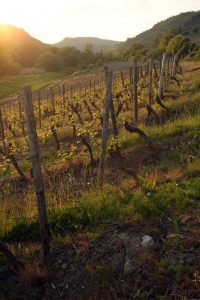 Oberhäuser Brücke
Oberhäuser Brücke
Oberhäuser Brücke (grey slate with a layer of loess and loam) is named for the Luitpold Bridge which crosses the Nahe at Oberhäusen, towards Niederhäusen. Brücke is a monopole site of just over a single hectare that sits directly on the Nahe river, facing south, southeast. This site is not steep, nor is it as imposing or dramatic as Felsenberg or Hermannshöhle but the wines produced from this sheltered site are among the very best in the whole region. The sheltered aspect and the moderating influence from the river allow for early flowering, a long growing season as well as an even water supply. It’s a site where all styles are possible, the only variable is the growing conditions of the vintage.
The wines are always sophisticated, elegant, and serene. While the wines always have a high level of concentration, they never feel overblown or overwrought. “Brücke is always somewhat of a mystery,” says Cornelius. “The wine has so much character, it can be so many different styles from powerful and dry to intense BA and TBA. And yet it is always distinctive. Even when you have several different styles of wine on the table, the character of the vineyard is always shining through”.
In 2015, Brücke GG was produced for the first time. When we first tasted this wine in 2016, it was a revelation. While this was the first wine to bear the VDP’s GG marker (the first GG produced at this estate was 2003) there have always been top dry wines produced from these vineyards at Dönnhoff. While sitting around the table tasting, Helmut descended to the cellar, returning with a 1989 Brücke Auslese Trocken. The wine was excellent, but Helmut made an interesting remark: “The quality of fruit that has gone into the current GG is much different than the type of fruit that went into the 1989 dry wine. At this period, the wines which would fetch the highest prices were the off-dry prädikatswein, with the dry wines playing a smaller role. The scales are different now and the success of GG means that the very best and very cleanest fruit is destined for making dry wines”. The amount of Grosses Gewächs produced from this site is tiny, and has not been produced each year, only in exceptional vintages. The Brücke GG is now offered only through the auction, while the outstanding, gorgeously balanced, and finely-detailed Spätlese is a wine that we are able to offer each year.
The 2019 vintage for Brücke is incredible. The Spätlese was harvested at the same time as the GG, without botrytis. “We leave the botrytis for the Auslese,” said Cornelius. It’s incredibly focused, direct flavor, straight, high toned, and open while still leaving a bit in the shadow. It smells like spring full bloom floral and shimmering. The texture is unmistakably Brücke, richer and more base note than the Kirschheck and deeper too. There is something mysterious about this wine, but there always is. “If Kirschheck is watching a movie, Brücke is reading a book,” remarked Cornelius. The Auslese produced was 50% of a normal year as the pressing was so light on the botrytized fruit. What was left was a superbly clear wine that was a true Auslese, not a baby BA, delicious and drinkable even in its youth.
Neiderhäuser Klamm
Neiderhaüser Klamm (volcanic porphyr and decomposed slate) was acquired as part of a purchase that included a small section of the hallowed Hermannshöhle vineyard. “It took us several years to really see what the character of the vineyard was and what kind of wine we could produce. We tried a few different styles, but the Kabinett seemed to always shine here,” said Cornelius.
Klamm is a very old word, alluding to a craggy hollow in the cliffs here: a protected depression in the hillside just a hundred meters away from Hermannshöhle.
The first vintage of Klamm Kabinett was 2018 and 2019 shows a more of a crisp character. The mid-palate is ripe, with a ripe pit fruit character balanced with ripe citrus and a volcanic spiciness that might remind us slightly of Felsenberg.
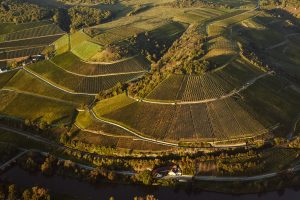 Niederhäuser Hermannshöhle
Niederhäuser Hermannshöhle
Niederhaüser Hermannshöhle (clay-slate with limestone and volcanic veins) is the most famous vineyard in the Nahe. Regarded as the benchmark site for the region for over one hundred years, this 8.5ha conical-shaped hillside of slate, with bands of volcanic soil and limestone, rises up over a slight bend in the Nahe. It’s the crown jewel of all vineyards in the region. Dönnhoff’s wines are a shining example of what this site can produce, from the delicious Spätlese to the concentrated, yet electric Auslese ‘Goldkapsel’ and the stunning Grosses Gewächs. “Hölle” means “hole” and the name “Hermann” is likely derived from Hermes, the messenger of the gods and patron of travelers. If Felsenberg is the god of thunder, then surely Hermannshöhle is the god of wisdom.
Describing the flavor of the wines from Hermannshöhle is probably best left to a taster who has yet to experience the wine; after tasting wines from this vineyard several times, the descriptions become quickly replaced with metaphors.
Several years ago Cornelius was asked by an excellent young taster who was traveling with us “what are the markers for Hermannshöhle?” Cornelius waited a beat and said,
When the wine is finally in bottle, I will have tasted it so many times it feels just like a place in time. When I taste this wine, I am tasting the conditions of that particular vintage; I can feel the cold of springtime and the warmth of summer. I can feel the rainfall in late summer as the seasons changed to fall and the grapes ripened.
To me, the taste of this wine is so linked to the place and the feeling that it is indescribable. It’s really difficult to separate these things and to say ‘Hermannshöhle tastes of white peach and grey salt’. It doesn’t work that way in my mind. The wine isn’t about an aroma or a fruit flavor, which fades with time. It is about the feeling of the place”
It tastes like Hermannshöhle; which is to say that nothing else tastes quite like it.




